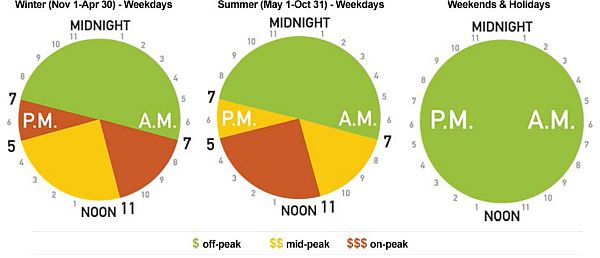Smart Meters
Ontario has introduced smart meters — along with a “time-of-use” electricity price structure — to help you manage your electricity costs, while helping Ontario to build a more efficient, more environmentally sound electricity system. Smart meters have been installed in residences and small businesses across Ontario.
What is a smart meter?
A smart meter electronically tracks how much electricity a home or small business uses and when it is used. With that information, electricity prices can vary at different times of the day, encouraging you to think more about how and when you use electricity. This detailed information appears on your electricity bill to help you manage your electricity costs.
You can get more detailed information about how smart meters work on the Independent Electricity System Operator website.
What is time-of-use pricing?
Smart meters make it possible to introduce time-of-use pricing to homes and small businesses.
Time-of-use pricing is a rate structure that reflects the costs associated with electricity production throughout the day. Prices rise and fall over the course of the day and tend to drop overnight and on weekends, depending on demand and the availability of supply:
- Off-peak is when demand is low and less expensive sources of electricity are used.
- Mid-peak is when the cost of energy and demand are moderate.
- On-peak is when demand is highest and more expensive forms of electricity production are required.
Time-of-use pricing provides you with a new way to manage energy costs. For example, you may choose to shift some of your electricity use to mid-peak and off-peak times when it is less expensive.
The Ontario Energy Board (OEB) sets the daily and seasonal time-of-use prices and periods and reviews the prices every May 1 and November 1. Learn more about time-of-use prices and review the current rates on the OEB website.
Why are smart meters and time-of-use pricing necessary?
Time-of-use pricing encourages Ontarians to shift some electricity use to off-peak hours. By reducing peak demand, the province can reduce its use of the less environmentally attractive resources that are called on when demand is high. In the long run, lower peak demand will mean less need for new generating facilities and transmission and distribution infrastructure, lowering costs for all Ontarians.
A smart meter system opens up the opportunity for new kinds of conservation and demand management programs. In the future, smart meters could allow the introduction of different time-based incentive programs, or the opportunity for you to control your energy use through energy management devices or smart appliances. Smart meter data also provides comprehensive, detailed information for electricity system planning, allowing us to identify where future generation, transmission and distribution investments are required.
How do smart meters and time-of-use pricing benefit me?
- With a smart meter and time-of-use rates, you are able to take advantage of lower rates by switching some of your energy use to mid- and off-peak periods.
- Smart meters provide accurate feedback about your electricity consumption. Your electricity bill provides a summary of your consumption during each time-of-use rate period over the previous billing period. In the future, you will also be able to get information about your electricity use the next day over the Internet and/or by telephone.
- In the future, smart meters will make it possible for people to use such innovations as home energy management systems and electric vehicles.
Smart Meter Resources
A smart meter tracks how much electricity you use and when you use it — key information to help you better manage your electricity costs. In Ontario, all homes and small businesses will be equipped with smart meters by the end of the decade.
Get the answers to some of your smart meter questions.
For more information visit:






 Accessibility
Accessibility